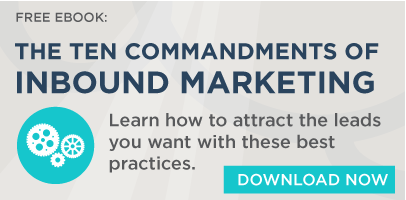
One of my guilty pleasures is watching the TV show "Gold Rush" on the Discovery Channel. The show follows three teams of Alaska gold miners as they battle the elements, broken-down equipment, and each other to find a few ounces of gold dust buried deep in the rough Alaska terrain. They experience emotional highs when they discover a gold-rich vein and lows when they come up empty.
There are many parallels between the lives of a gold miner and that of an inbound marketing. Miners are looking for nuggets of gold that can make them wealthy, and inbound marketers are looking for equally elusive qualified leads that can drive next quarter’s revenue growth. Both pursuits require persistence and a consistent effort. Below are some additional lessons marketers can learn from our friends on Gold Rush.
1. Stake your claim.
The miners don’t just go out and find a random chunk of land and start digging. They review geological maps, talk to experts and test soil samples first. Before they start they already have a pretty good idea that they will find gold where they dig. They just don’t know how much they’ll find and how much effort and time it will require to get it out of the ground.
Similarly, marketers don’t just start launching random campaigns and then cross their fingers. Staking their claim means identifying their target market and defining their buyer personas. Marketers should have a pretty good idea that their message will resonate and opportunities exist before they start to “dig” with their marketing campaign launch.
2. Put the right infrastructure in place.
The tools used for gold mining includes bull dozers, dump trucks, trammels, wash plants and front-end loaders. The miners have teams of people that have the expertise to run and repair the equipment. Much of the drama on the Gold Rush show occurs when their equipment breaks down. They know that when their equipment is idle, they can’t find the gold.
Infrastructure is equally important to marketers. Instead of heavy equipment, though, we rely on things like websites, social media, CRM and marketing automation. Each of these tools are vital to the success of our marketing plans. However, many times we have the tools, but they’re broken and not being used effectively. For example, having a website that doesn’t have lead capture functionality is like a gold miner running a gold mine without a sluice box to capture the gold nuggets. They move a lot of dirt and we create a lot of activity, but neither of us have anything to show at the end of the day. Another example is CRM tools. How many organizations have invested in a CRM that for the most part sits idle because their sales teams refuse to use it. It’s not much different than a piece of heavy equipment that is in perfect working condition, but everyone refuses to operate.
3. Keep your plant running.
The Alaskan gold miners have a short season where they can be productive. They start when the permafrost begins to thaw and their season ends with the first winter snow. Consequently, they must make every minute count. They run their tractors and wash plants 24 hours per day, 7 days per week. They know that they need to push tons of dirt through their wash plants in order to extract just a few ounces of gold.
Consistent effort is also key to an effective inbound marketing strategy. Month-over-month increases in traffic and lead conversions requires a regular supply of fresh content (blog articles, eBooks, whitepaper, etc.), offers and campaigns. A Company that stops publishing content and quits promoting is like a miner who stops digging. One of the benefits of an inbound marketing strategy is that it never takes a day off. The content that’s created and published online can work for you 24 x 7 x 365.
4. Stop and measure your results.
At the end of each week, the Gold Rush miners clean out their sluice boxes so they can determine how much gold they were able to capture. They painstakingly collect every speck of gold they can and they measure their output. The primary indicator of success is the number ounces of gold they uncover. But that’s not all they measure. They also measure how many yards of dirt they hauled, the number of hours their wash plant ran, the amount of fuel they burned, and the number of “man hours” worked. These are all KPIs that help them monitor their success. If their “conversion rate” from yards of dirt hauled to ounces of gold found is low, then they know they need to reevaluate their strategy.
Measurement is critical for a successful marketing strategy as well. Marketers must measure and periodically evaluate the KPIs critical to their success. These KPIs include website visitors, MQL conversion rate, and SQL conversion rate. If the conversion rates are too low, marketers likewise need to reevaluate their strategy. The first step is optimizing results is always measuring and monitoring the KPIs.
.png)








Leave a Comment